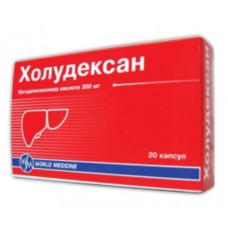Expiration date: 09/2026
Composition
1 capsule contains:
active substance: ursodeoxycholic acid 300 mg
Packaging
20 capsules.
Pharmacological action
Choludexan - hepatoprotective tool also has choleretic, cholelitolitic, hypolipidemic, hypocholesteremic and some immunomodulatory effects.
With high polar properties, ursodeoxycholic acid (UDCA) forms a non-toxic mixed micelles with non-polar (toxic) bile acids, which reduces the ability of gastric reluctate to damage cell membranes in biliary reflux-gastritis and reflexitivity. In addition, UDCA forms double molecules, to be included in the composition of the cell membrane (hepatocytes, cholangiocytes, epithelial cells of the digestive tract), to stabilize them and make them impervious to the action of cytotoxic micelles. Reducing the concentration of toxic to the liver cells of bile acids and stimulating holert, rich in bicarbonates, UDCA effectively contributes to the resolution of intrahepatic cholestasis. Reduces the saturation of bile with cholesterol due to inhibition of its absorption in the intestine and suppressing synthesis in the liver and lowering the secretion of bile, increases the solubility of cholesterol in bile, forming with it liquid crystals, reduces the lithogenic index of bile.
The result is the dissolution of cholesterol gallstones and prevention of formation of new stones. Immunostimulating effect is due to inhibition of expression of HLA antigens-1 on the membranes of hepatocytes and HLA-2 cholangiocyte, normalization of natural killer activity of lymphocytes, etc. Significantly delays the progression of fibrosis in patients with primary biliary cirrhosis, cystic fibrosis and alcoholic steatohepatitis, reduces the risk of developing varicose veins of the esophagus. UDCA slows down the process of premature aging and death of cells (hepatocytes, cholangiocytes, etc.)
Pharmacokinetics
UDCA is absorbed in the small intestine by passive diffusion (about 90%) and in the ileum by active transport: Cmax when administered 50 mg 30, 60, 90 minutes, 3, 8 mmol/l 5.5 mmol/l and 3.7 mmol/l, respectively. Cmax is reached in 1-3 hours.
The relationship with the squirrels high up to 96-99 %. Penetrates through the placental barrier. At regular admission Choludexan-UDCA becomes the major bile acid in serum and constitutes about 48% of the total bile acids in the blood. The therapeutic effect of the drug depends on the concentration. UDCA in bile.
Metabolized in the liver (clearance in the primary passage through the liver) taurine and glycine conjugates. The resulting conjugates are secreted into bile. Around-50-70% of the total dose is excreted in the bile. A small number nevsosavsheysya UDCA enters the large/ intestine, where it undergoes cleavage by bacteria: (dihydroxypropane) formed litojolevu acid is partly absorbed from the colon, but sulfatides in the liver and rapidly excreted in the form of sulfonatophenyl glycine, or sulfatecontaining conjugate.
Testimony
- uncomplicated gallstone disease (biliary sludge, the dissolution of cholesterol gallstones in gallbladder by impossibility of their surgical or endoscopic removal methods, prevention of stone recurrence after cholecystectomy),
- chronic active hepatitis,
- toxic (including drugs) liver disease,
- alcoholic liver disease (ALD),
- non-alcoholic steatohepatitis,
- primary biliary cirrhosis,
- primary sclerosing cholangitis,
- cystic fibrosis,
- atresia of the intrahepatic bile ducts, congenital atresia of the bile duct,
- biliary dyskinesia,
- biliary reflux-gastritis and reflux-esophagitis.
Contraindications
- roentgenologically (high in calcium) gall stones
- nonfunctioning gallbladder
- biliary-gastric fistula
- acute cholecystitis,
- acute cholangitis,
- liver cirrhosis in the decompensation stage,
- acute infectious diseases of the gallbladder, bile ducts and intestines,
- severe hepatic and/or renal failure,
- obstruction of the biliary tract,
- empyema of the gall bladder,
- children up to age 3 years
- hypersensitivity to the drug.
Caution: although UDCA. has no age restrictions in the application, be used with caution, capsules Choludexan in children at the age from 3 up to 4 years, as possible difficulty swallowing capsules.
Application of pregnancy and breastfeeding
Women of childbearing age in the period of the drug is recommended to use non-hormonal contraception. The use of UDCA during pregnancy is possible only in the case when expected benefit for mother exceeds the potential risk to the fetus (adequate well-controlled studies of the use of UDCA in pregnant women is not conducted). Data on the allocation of UDCA in breast milk are not currently available. If necessary, the use of UDCA in the period of lactations should solve the issue of termination of breastfeeding
Method of application and doses
Choludexan is taken orally, drinking plenty of water with biliary reflux-gastritis and reflux-esophagitis - 1 time a day, before bed, in diffuse diseases of the liver, 2-3 times per day with food.
Chronic liver disease, cholelithiasis (cholesterol gall-stones and biliary sludge) is continuously for a long time (from several months to several years) in a daily dose of 10 mg/kg up to 12-15 mg/kg (2-5 capsules)! The duration of intake of dissolving the stones to dissolve plus another 3 months for the prevention of stone recurrence.
In biliary reflux-gastritis and reflux-esophagitis - 300 mg (1 capsule) a day, before bedtime. The course of treatment - from 10-14 days to 6 months, if needed up to 2 years.
After cholecystectomy for prevention of repeated cholelithiasis - 300 mg 2 times per day for several months.
Toxic, drug-induced liver injury, ABP and atresia gelong ways - 10-15 mg/kg/day for 6-12 months or more.
Primary biliary cirrhosis - 10-15 mg/kg/day (if necessary - to 20 mg/kg) from 6 months to several years.
Primary sklerosiruuschem cholangitis - 12-15 mg/kg/day, (up to 20 mg/kg) from 6 months to several years.
Non-alcoholic steatohepatitis -13-15 mg/kg/day from 6 months to several years.
Cystic fibrosis: 20-30 mg/kg/day (20 mg/kg) from 6 months to several years.
Children over 3 years of UDCA administered individually, at the rate of 10-20 mg/kg/day.
Side effects
- Back pain,
- nausea,
- vomiting,
- diarrhea (can be dose-dependent),
- constipation, transient (transient) increase in liver transaminases,
- allergic reactions,
- rare - the calcination of gallstones
- aggravation of pre-existing psoriasis,
- alopecia.
Special instructions
While taking the drug with the purpose of dissolving gallstones, you must meet the following conditions: the stones must be cholesterol (roentgen), their size should not exceed 15-20 mm, the gall bladder should remain functional and should be filled with stones not more than half the patency of the cystic and common bile duct should be preserved. With prolonged (more than 1 month) taking the drug every 4 weeks in the first 3 months of treatment, and thereafter every 3 months to carry out the biochemical analysis of blood to determine liver transaminases. Control of treatment efficiency should be performed every 6 months according to the ultrasound and x-ray examination of the biliary tract. After full dissolution of stones is recommended to continue the application Choludexan for at least 3 months, in order to facilitate the dissolution of the remnants of stones whose dimensions are too small for their detection and for the prevention of recurrence of stone formation.
If within 6 months after the start of therapy partial dissolution of stones did not happen, it is unlikely that treatment will be effective.
Use in Pediatrics
As possible difficulty swallowing capsules, the drug should not be used in this dosage form in children under the age of 3, children aged 3 to 4 years used with caution.
Effects on ability to drive vehicles and management mechanisms
The drug has no negative effect on the ability to drive vehicles and/or other mechanisms.
Drug interactions
Antacids containing aluminum and ion-exchange resins (cholestyramine), reduce the absorption of the drug. Lipid-lowering drugs (especially clofibrate estrogens, progestins increase neomycin or
saturation of bile with cholesterol and may reduce the ability to dissolve cholesterol gall stones. Increases effect of oral hypoglycemic drugs.
Overdose
An overdose is unlikely because the absorption of ursodeoxycholic acid decreases with increasing dose and most of it is excreted in the feces.
Storage conditions
The drug should be stored out of reach of children at temperature from 15° to 25°C.


